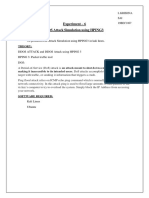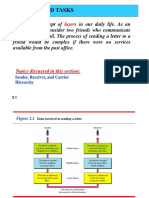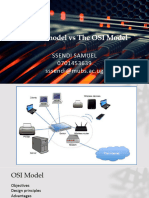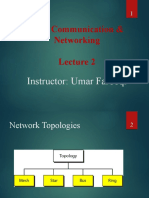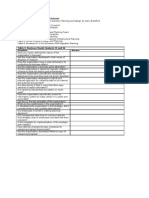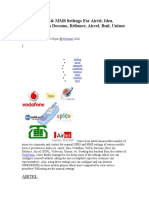Data and Computer Communications: - Protocol Architecture, TCP/IP, and Internet-Based Applications
Uploaded by
Hamza HasnyneData and Computer Communications: - Protocol Architecture, TCP/IP, and Internet-Based Applications
Uploaded by
Hamza HasnyneData and Computer
Communications
Chapter 2 Protocol Architecture,
TCP/IP, and Internet-Based
Applications
2.2
2-1 LAYERED TASKS
We use the concept of layers in our daily life. As an
example, let us consider two friends who communicate
through postal mail. The process of sending a letter to a
friend would be complex if there were no services
available from the post office.
2.3
Figure 2.1 Tasks involved in sending a letter
Transport
Application
Network access
Application
Transport
Network access
Simplified Network
Architecture
2.5
2-2 THE OSI MODEL
Established in 1947, the International Standards
Organization (ISO) is a multinational body dedicated to
worldwide agreement on international standards. An ISO
standard that covers all aspects of network
communications is the Open Systems Interconnection
(OSI) model. It was first introduced in the late 1970s.
2.6
Figure 2.2 Seven layers of the OSI model
2.7
Figure 2.4 An exchange using the OSI model
2.8
Figure 2.5 Physical layer
The physical layer is responsible for movements of
individual bits from one hop (node) to the next.
2.9
Figure 2.6 Data link layer
The data link layer is responsible for moving
frames from one hop (node) to the next.
2.10
Figure 2.8 Network layer
The network layer is responsible for the
delivery of individual packets from
the source host to the destination host.
2.11
Figure 2.10 Transport layer
The transport layer is responsible for the delivery
of a message from one process to another.
2.12
Figure 2.12 Session layer
The session layer is responsible for dialog
control and synchronization.
2.13
Figure 2.13 Presentation layer
The presentation layer is responsible for translation,
compression, and encryption.
2.14
Figure 2.14 Application layer
The application layer is responsible for
providing services to the user.
2.15
Figure 2.15 Summary of layers
TCP/IP Protocol Architecture
developed by US Defense Advanced
Research Project Agency (DARPA)
for ARPANET packet switched network
used by the global Internet
protocol suite comprises a large collection
of standardized protocols
TCP/IP Layers
no official model but a working one
Application layer
Host-to-host, or transport layer
Network access layer
Physical layer
2.18
Figure 2.16 TCP/IP and OSI model
Physical Layer
concerned with physical interface between
computer and network
concerned with issues like:
characteristics of transmission medium
signal levels
data rates
other related matters
Network Access & internet
Layer
exchange of data between an end system
and attached network
concerned with issues like :
destination address provision
invoking specific services like priority
access to & routing data across a network link
between two attached systems
allows layers above to ignore link specifics
routing functions across multiple networks
for systems attached to different networks
using IP protocol
implemented in end systems and routers
routers connect two networks and relays
data between them
Network Access & internet
Layer
Transport Layer (TCP)
common layer shared by all applications
provides reliable delivery of data
in same order as sent
commonly uses TCP
Application Layer
provide support for user applications
need a separate module for each type of
application
Operation of TCP and IP
TCP/IP Applications
have a number of standard TCP/IP
applications such as
Simple Mail Transfer Protocol (SMTP)
File Transfer Protocol (FTP)
Telnet
You might also like
- Experiment - 6 DOS Attack Simulation Using HPING3No ratings yetExperiment - 6 DOS Attack Simulation Using HPING316 pages
- SANOG23 Introduction To Routing Tutorial PDFNo ratings yetSANOG23 Introduction To Routing Tutorial PDF219 pages
- Data and Computer Communications: - Protocol Architecture, TCP/IP, and Internet-Based ApplicationsNo ratings yetData and Computer Communications: - Protocol Architecture, TCP/IP, and Internet-Based Applications34 pages
- Chapter 5: TCP/IP and OSI: Business Data Communications, 5eNo ratings yetChapter 5: TCP/IP and OSI: Business Data Communications, 5e40 pages
- Chapter2 Network Model 09102020 041049pmNo ratings yetChapter2 Network Model 09102020 041049pm33 pages
- Lecture 5 - 6 Data Communication and Networking: BY Muhammad AfzalNo ratings yetLecture 5 - 6 Data Communication and Networking: BY Muhammad Afzal36 pages
- Major Networking Concepts: Reference Models: Kashif AmjadNo ratings yetMajor Networking Concepts: Reference Models: Kashif Amjad48 pages
- Data Communications and Networks (IT-213) : Spring 2021No ratings yetData Communications and Networks (IT-213) : Spring 202159 pages
- 81w1cexs3rahbigsijrfgqombgkcurnqbcsf4pck9tssbmvslmeldtgc61cjecgkmmt2qzqnnlpxoydv7915go63 Kixzfnol0z Ktdxudmcuzzu8gp60ekp5ofcu1jz2wp9es2bjec x3cgqi Vwuwrpqy5z Riobebq9wzwuhdbepitnpkmusagh4zefajci f9e Lmhblz60kq5ffp1mNo ratings yet81w1cexs3rahbigsijrfgqombgkcurnqbcsf4pck9tssbmvslmeldtgc61cjecgkmmt2qzqnnlpxoydv7915go63 Kixzfnol0z Ktdxudmcuzzu8gp60ekp5ofcu1jz2wp9es2bjec x3cgqi Vwuwrpqy5z Riobebq9wzwuhdbepitnpkmusagh4zefajci f9e Lmhblz60kq5ffp1m81 pages
- Ministry of Water Resources and ElectricityNo ratings yetMinistry of Water Resources and Electricity26 pages
- 04 Layered Architecture of Computer Networks OSI and TCPIP Model Lecture 5No ratings yet04 Layered Architecture of Computer Networks OSI and TCPIP Model Lecture 569 pages
- Data Communication & Networking: Instructor: Umar FarooqiNo ratings yetData Communication & Networking: Instructor: Umar Farooqi61 pages
- Semester v - Computer Networks(Cs8591)_compressedNo ratings yetSemester v - Computer Networks(Cs8591)_compressed430 pages
- CS 408 Computer Networks: Chapter 2: Protocols and The TCP/IP Protocol SuiteNo ratings yetCS 408 Computer Networks: Chapter 2: Protocols and The TCP/IP Protocol Suite59 pages
- Networking Self-Teaching Guide: OSI, TCP/IP, LANs, MANs, WANs, Implementation, Management, and MaintenanceFrom EverandNetworking Self-Teaching Guide: OSI, TCP/IP, LANs, MANs, WANs, Implementation, Management, and MaintenanceNo ratings yet
- Cost Benefits and Critical Success FactorsNo ratings yetCost Benefits and Critical Success Factors3 pages
- Data Communications, Data Networks, and The InternetNo ratings yetData Communications, Data Networks, and The Internet20 pages
- IAT-2-2 MARKS QB-CCS354 Network SecurityNo ratings yetIAT-2-2 MARKS QB-CCS354 Network Security6 pages
- Manual GPRS & MMS Settings For Airtel, Idea, Vodafone, Tata Docomo, Reliance, Aircel, BSNL, Uninor and VideoconNo ratings yetManual GPRS & MMS Settings For Airtel, Idea, Vodafone, Tata Docomo, Reliance, Aircel, BSNL, Uninor and Videocon11 pages
- Gilas Pilipinas, Nakaresbak Sa Cambodia Ginto Sa SEAG Basketball, Nakuha - 101120No ratings yetGilas Pilipinas, Nakaresbak Sa Cambodia Ginto Sa SEAG Basketball, Nakuha - 1011202,341 pages
- Data and Computer Network Communication PDFNo ratings yetData and Computer Network Communication PDF795 pages
- 10.1.2.5 Packet Tracer - Propagating A Default Route in OSPFv2 InstructionsNo ratings yet10.1.2.5 Packet Tracer - Propagating A Default Route in OSPFv2 Instructions3 pages
- DVS-016 Series: Unmanaged Industrial 16-Port FE Ethernet SwitchesNo ratings yetDVS-016 Series: Unmanaged Industrial 16-Port FE Ethernet Switches2 pages
- Network Documentation: Network Monitoring and ManagementNo ratings yetNetwork Documentation: Network Monitoring and Management34 pages
- CISA Exam-Testing Concept-OSI Architecture (Domain-5)From EverandCISA Exam-Testing Concept-OSI Architecture (Domain-5)
- Data and Computer Communications: - Protocol Architecture, TCP/IP, and Internet-Based ApplicationsData and Computer Communications: - Protocol Architecture, TCP/IP, and Internet-Based Applications
- Chapter 5: TCP/IP and OSI: Business Data Communications, 5eChapter 5: TCP/IP and OSI: Business Data Communications, 5e
- Lecture 5 - 6 Data Communication and Networking: BY Muhammad AfzalLecture 5 - 6 Data Communication and Networking: BY Muhammad Afzal
- Major Networking Concepts: Reference Models: Kashif AmjadMajor Networking Concepts: Reference Models: Kashif Amjad
- Data Communications and Networks (IT-213) : Spring 2021Data Communications and Networks (IT-213) : Spring 2021
- 81w1cexs3rahbigsijrfgqombgkcurnqbcsf4pck9tssbmvslmeldtgc61cjecgkmmt2qzqnnlpxoydv7915go63 Kixzfnol0z Ktdxudmcuzzu8gp60ekp5ofcu1jz2wp9es2bjec x3cgqi Vwuwrpqy5z Riobebq9wzwuhdbepitnpkmusagh4zefajci f9e Lmhblz60kq5ffp1m81w1cexs3rahbigsijrfgqombgkcurnqbcsf4pck9tssbmvslmeldtgc61cjecgkmmt2qzqnnlpxoydv7915go63 Kixzfnol0z Ktdxudmcuzzu8gp60ekp5ofcu1jz2wp9es2bjec x3cgqi Vwuwrpqy5z Riobebq9wzwuhdbepitnpkmusagh4zefajci f9e Lmhblz60kq5ffp1m
- 04 Layered Architecture of Computer Networks OSI and TCPIP Model Lecture 504 Layered Architecture of Computer Networks OSI and TCPIP Model Lecture 5
- Data Communication & Networking: Instructor: Umar FarooqiData Communication & Networking: Instructor: Umar Farooqi
- CS 408 Computer Networks: Chapter 2: Protocols and The TCP/IP Protocol SuiteCS 408 Computer Networks: Chapter 2: Protocols and The TCP/IP Protocol Suite
- Networking Self-Teaching Guide: OSI, TCP/IP, LANs, MANs, WANs, Implementation, Management, and MaintenanceFrom EverandNetworking Self-Teaching Guide: OSI, TCP/IP, LANs, MANs, WANs, Implementation, Management, and Maintenance
- Data Communications, Data Networks, and The InternetData Communications, Data Networks, and The Internet
- Manual GPRS & MMS Settings For Airtel, Idea, Vodafone, Tata Docomo, Reliance, Aircel, BSNL, Uninor and VideoconManual GPRS & MMS Settings For Airtel, Idea, Vodafone, Tata Docomo, Reliance, Aircel, BSNL, Uninor and Videocon
- Gilas Pilipinas, Nakaresbak Sa Cambodia Ginto Sa SEAG Basketball, Nakuha - 101120Gilas Pilipinas, Nakaresbak Sa Cambodia Ginto Sa SEAG Basketball, Nakuha - 101120
- 10.1.2.5 Packet Tracer - Propagating A Default Route in OSPFv2 Instructions10.1.2.5 Packet Tracer - Propagating A Default Route in OSPFv2 Instructions
- DVS-016 Series: Unmanaged Industrial 16-Port FE Ethernet SwitchesDVS-016 Series: Unmanaged Industrial 16-Port FE Ethernet Switches
- Network Documentation: Network Monitoring and ManagementNetwork Documentation: Network Monitoring and Management


